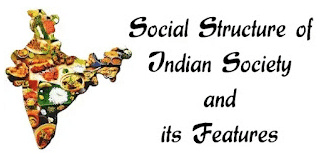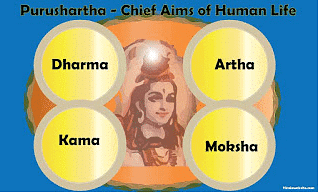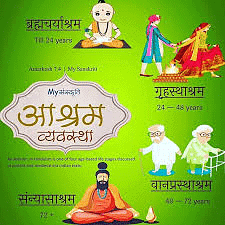Structure of Indian Social System | Anthropology Optional for UPSC PDF Download
The Structure & Nature of traditional Indian Social System | Varnashram, Purushartha, Karma, Rina | Features

- Since ancient times, the social structure of traditional Indian society has been based mainly on the hereditary principle. The members were divided into hereditary caste groups, each caste with its traditional occupation. The actions of any individual in ancient Indian society were inherently structured on a normative, teleological socio-cultural group pattern. The normative structure consisted of Purushartha-Dharm, Artha, Kama, and Moksha.
- A person in this scheme of life was expected to behave in a pattern laid out for a religious sect and caste and achieve the goal of self-realization. This ideology of Indian society was followed in the ancient period through a synthesis of the system described in the Gita, the Smritis, and Arthasastra. This was, in fact, the model of Sanatan Dharm, the eternal religion.
Social Structure of Indian Society
- Social structure denotes the network of social relationships. The social relationship is created among the individuals when they interact with each other according to their statuses in accordance with the patterns of society. In a social structure, individuals having common objects organize themselves into associations. Social structure is an abstract phenomenon. It denotes the external aspects of society.
- Each society has a pattern of organization, which has structures that result from the association of individuals with one another. It may be a group, institution, association, community, or an organization all of which are parts of social structure through which it functions.
Purusharthas

- Purusharthas refer to the goals or aims of life. They form the psycho-moral basis of the Ashramas - the individual through the Ashramas gets trained in the use and management of Purusharthas. There are four Purusharthas:
- Dharma: Means "to hold together or to preserve" and is the principle for maintaining the stability of a society. It is central to all human activities. Dharma stands on a higher level, while Artha and Kama refer to man's earthly belongings. The lowest level is occupied by the Kama and is said to be one of the six enemies of man, collectively called the Arishadvargas.
- Artha: Refers to all the means necessary for acquiring worldly prosperity like power and wealth.
- Kama: Refers to all the desires in man for the enjoyment and satisfaction of the senses of life including sexual satisfaction.
- Moksha: It is salvation, liberation from the endless cycle of births and deaths. It refers to the absorption of self into eternal bliss.
- The material means: Artha and the propagation of species - Kama is necessary for the manifestation or conduct of human life. But they should be incorrect quality and quantity, this is done by Dharma.
- In a proper, coordinated and careful management of Dharma, Artha and Kama lies the secret of a good humanity
Rina
Every individual has to pass through the four Ashramas of life one after the other and pursue each of them to obtain Moksha. Before entering into the last phase, Sanyasasrama, he has to satisfy himself that he has carried out the duties and obligations laid down for each of the earlier Ashramas. He also has to see that he has duly given his dues in connection with the social obligations or debts. These debts are referred to as "Rinas". They are :
- Deva Rina: It's a debt one owes to Gods and Goddesses and may be repaid through the recitation of Vedas, offering sacrifices, performing Yagna.
- Rishi Rina: This is the obligation to the rishis and gurus through whom one acquires knowledge and thus removes the darkness of mind and soul. It is repaid by giving guru Dakshina, studying the Vedas, and obeying the code of conduct of Brahmacharya ashrama.
- Pitri Rina: One owes one's existence to one's parents. This debt is repaid by reproducing Santana and making them good human beings and useful members of society.
- Atithi Rina: Atithi(guests) have been equated with God’s whose service is an important element of Hindu Social Order. This debt can be repaid by showing reverence and serving guests in the best possible way.
Asramas

The word Asrama is originally derived from the Sanskrit root "Srama"- to exert oneself. Literally, Asrama is halting-place i.e, stop in the journey of life, for rest, in order to prepare oneself for the further journey on the way to final liberation(moksha). they are four ashramas:
- Brahmacharyasrama
- Grihastasrama
- Vanaprastharama
- Sanyasasrama
Brahmacharyasrama:
- Concerns itself with the management of education as a social institution. the upanayana sacrament is virtually regarded as the second birth of a young boy, till upanayana is not conducted every child is considered nature born and as such, as good as shudra. after upanayana, he becomes Dwija- twice-born.
- Once the upanayana ceremony is performed, the boy learns first lessons in simple living and gets his training irrespective of the position or status of the family in which he is born. and stars begging alms for his teacher, he is forbidden from accepting anything except alms.
- Dress habits of students belonging to different varnas also differ, which goes according to scripts. higher the Verna to which student belongs, less luxurious the piece of the garment he wears.
- In Brahmacharyasrama the student has to keep his tongue, arms, and stomach under control and discipline to attain his vows. thus, the student is being trained in the habit of the simple life, no matter to what family he belonged.
- Apart from Vedas, many other sciences are also studied by the student through his guru and the latter's duty towards his pupil is to impart to him whatever truth he knows. Since the teacher charges no fee from the pupil for his labor, the moral influence of the teacher upon his pupil has an added weight.
- After the student has completed the course of his studies, he leaves the place of his teacher and journeys back home, and now he is ready to enter next Asrama i.e, Grihastha.
Gruhastasrama
The real family life of a person, who has completed his course of the Brahmacharyasrama starts with his marriage. A person now has to practice all those rites intended for the preservation and continuity of his family. he has to follow according to regulation and directions laid down by texts, the domestic activities, the duties, and five great sacrifices. These sacrifices are moral obligations of the householder. they are:
- Brahma Yagna [Recognizing the debt due to those who guide nature, and the feeding of them by offering ghee and uncooked grains into the fire.]
- Pitra Yagna [Offering of cakes (pinda) and water to the family line and the progenitors of mankind.]
- Deva Yagna [Recognizing the debt due to those who guide nature, and the feeding of them by offering ghee and uncooked grains into the fire.]
- Bhuta Yagna [Placing food-offerings, Bali, on the ground, intended for animals, birds, insects, wandering outcastes and beings of the invisible worlds.]
- Manushya Yagna [Feeding guests and the poor, the hungry, clothing the naked, giving shelter to the homeless, comforting the distressed, and the student are all forms of Manushya Yajna.]
The performance of these five yajnas is conducive to the spiritual evolution or growth of a man. A home is a dwelling place not only of living members of the family but also the forefathers who have passed away and the grandchildren who are yet to arrive. For individuals, the samsara is a temporary field of action and his life in Grihastasrama must be lived and directed only in terms of dharma and karma. To the extent to which the individual performs these, he prepares himself for the next stage of life and then the final goal, the moksha.
Vanaprasthasram
Here the individual has to leave the shelter not only of the family and the home but of the village too, he must go to the forest and live there all the while starving to bring under control his senses of enjoyment in the following manner- has eaten vegetables and fruits only, deerskin or bark of the tree has to be used for clothing, no deliberate attempt to attain comforts have to be made by him and he should sleep on the floor and reside under a tree.
- Five grades of sacrifice performed in Grihastasrama are to be continued in this Asrama and out of whatever he collects for eating has to be offered to guests who may visit him. Reading of sacred texts to elevate his soul to higher levels has to be followed.
- If a person dies in Vanaprastasrma, he is expected to attain moksha by reaching the region of Brahma.
Sanyasasrama
All entry into the last Asrama of Sanyasa is inevitable if an individual survives the Vanaprastarama, by casting off all the attachment with the world. acc. to Manu, an individual can enter this last Asrama even after the completion of Grihastasram and some say that an individual can enter Sanyasarama after the Brahmachayasrama.
- An individual in this Asrama should be free from everything, possess nothing, should not depend on anybody, and move around all alone.
- All sins of a man who passes through this Asrama have washed away and thus attains the ultimate and final goal of existence- moksha.
Caste and Varna
- Opler morris defines caste as -"caste is hereditary and endogamous. It regulates social intercourse, graded in rank, and has an assembly which regulates internal affairs".
- Gurye also refers to restrictions on feeding and social intercourse, civil and religious disabilities.
- It is the accepted religious principles supporting the caste system that distinguishes it from other social stratification systems in the world.
- Varna has its first mention in the Rig Veda. It mentions three varnas- Brahma, kshatriya, Vaishya. There is no direct mention of Sudras but references to groups despised by Aryans like Agoya, Chandala, Nishadas.
- It is said that there was no hierarchy in varnas during the Vedic period and it emerged during the Brahmanical period.
- It was senate who stated caste and varna are not identical.
- Many anthropologists agree that caste is not a subdivision of varna. As the origin of caste has nothing with the origin of varna. Though in the process of development of caste they came to be associated with varnas I.e the hierarchy and mobility of caste came to be stated in varna terms.
- Importance of varna is that it furnishes an all India frame into which jatis fit and had helped the spread of uniform culture throughout the Hindu society.
- Yet varna model has led to misinterpretation of the realities of the caste system.
- Varna is a mere conceptual scheme for Hindu society as a whole but caste depicts the real situation of Hindu society.
Features of Social Structure of Indian Society:
The following are the Important features of the social structure of Indian society:
- Complex Society
Indian society is characterized as a pluralistic society because it possesses a complex social order. It suffers from a multitude of ethnic, linguistic, religious, and caste divisions. - Rural Society
About 70% of the Indian people live in villages. Indian villages continue to be underdeveloped. Even rural areas suffer from a lack of infrastructural facilities. - Economically Backward Country
India has made considerable progress in the fields of agriculture and industrialization. But still, it continues to be an economically backward country. A major part of our population continues to live below the poverty line. - Illiteracy
Illiteracy and ignorance among the people of India is another important feature of the social system in India. Concerted Governmental action and strong social support are needed in removing the rate of illiteracy. - Diversified Languages
Diversity in languages is another feature of the social environment in India. The Constitution of India recognizes 22 languages as the major languages, which are spoken by 87% of the population. Of them, Hindi is spoken by 31% of the population. Linguistic diversity and love and affection of people towards their regional languages have made the Government reorganize Indian states on the basis of languages. Hence, language has emerged as a key factor in the social and political climate in India. - Racial Diversity
As already stated, people belong to different races such as Aryan, Dravidian, and Mongolian. inhabit India. People in the Eastern States, have an affinity with the Mongolian race. Hence the racial Inter-mixing has taken place to a limited extent in India. The Constitution provides for secularism. But racial factor plays a major role in the real operation of socio-political processes in India. - Caste
Caste has been the predominant feature of the Indian social system. The Constitution has taken a great step towards the dilution of caste and casteism. Caste and Casteism have been playing an important factor in Social, Economic, Cultural, and Political life in India. - Existence of Communalism
The existence of communalism in society is another feature of the Indian social system. It constitutes a big danger to the unity and integrity of the nation. - Regionalism
People belonging to a particular region consider those who belong to other regions as outsiders. Diversities in caste, religion, language, and culture have contributed to forces of regionalism. - Tradition
In India, both tradition and modernity exist side by side. Tradition is clearly affected by modern trends and pressures.
|
108 videos|273 docs
|
FAQs on Structure of Indian Social System - Anthropology Optional for UPSC
| 1. What is the social structure of India? |  |
| 2. How does the caste system impact Indian society? |  |
| 3. What are the different castes in Indian society? |  |
| 4. Is the caste system still prevalent in India today? |  |
| 5. How is the social structure of India changing in modern times? |  |
















